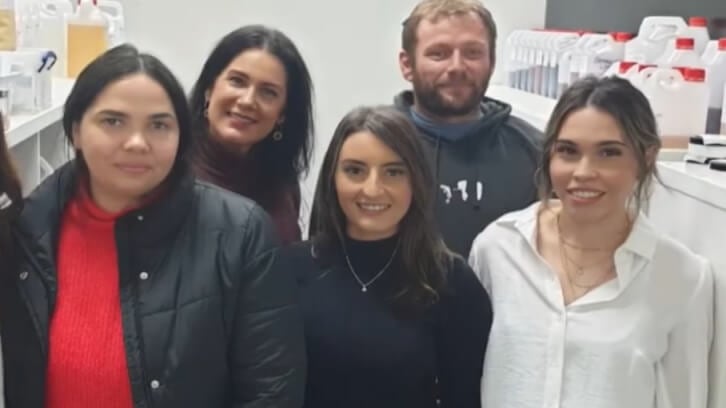In late 2022, Australian ingredients company NATIVE Extracts collaborated with indigenous grower Pundi Produce to mentor three First Nations Aboriginal entrepreneurs as they embarked on a journey to create their own beauty and personal care brands.
The initiative brought together some of Australia’s best skincare experts (growers, contract manufacturers, regulations experts and brands) to work alongside the three women, Stacy Wilson, Katisha Jackson and Tenesha Pickering.
The trio have enjoyed meetings and training sessions with NATIVE Extracts’ Director Lisa Carroll and Dominic Smith of Pundi Produce, as well as founders of successful beauty brands. They spent time assessing the market to scope out potential competitors and worked closely with hero ingredients from farm to bottle, learning all about growing plants and the cellular extraction process.
Each of the three women have now developed their first products, which are based on native Australian ingredients that have long been used for beauty and wellness purposes by their First Nation communities.
Stacy Wilson, a Ngarrindjeri woman and founder of Cutch, said the initiative gave the opportunity for “economic equality, elevation, self-sustainability” as well as “the opportunity to inspire future generations and promote inclusiveness to all people.”
“I feel like my brand is special due to the fact that I'm able to deliver products that merge the past and the future and allow everyone to experience First Nation culture,” she said.
Katisha Jackson, a Yorta Yorta and Wemba Wemba woman who founded Parnbandila held a similar view: “I’m proud to be able to identify my business as a First Nations brand. And to be able to share parts of my culture with the wider world – whether that be sharing my language, or the native ingredients that we've used for many years,” she said.
She continued: “Knowing that less than 2% of the agricultural and food sector is represented by Aboriginal people, and less than 0.2% of businesses in Australia are operated by Aboriginal and Torres Strait Islander women, gives me a great feeling of empowerment to be a part of that.”
While for Tenesha Pickering, a Ngarrindjeri woman who founded Graceful Tunkerri, being a First Nation brand gives an opportunity to “influence the younger generation of indigenous people to step out of their comfort zone.”
Discovering the NPD process
Each of the mentees have created their own brands and developed their first product, with the support and expertise of the NATIVE Extracts and Pundi Produce teams, as well as various other Australian businesses that have worked on the initiative.
Jackson said the NPD process had been an incredible learning experience, starting at the producer’s (Dominic’s) farm where they could see the products being grown and harvested, before then seeing the ingredients extracted at the NATIVE Extracts laboratory, and being sent on to the manufacturer for the product development process.
“I'm currently creating a repairing glow serum, and to be able to go through that process and then go through the testing and sample my product was an amazing journey so far,” she shared.
According to Wilson, growing up among powerful indigenous women informed her product development and she hoped that her authentic cultural connections would shine through in the brand.
“Bringing skincare that is connecting through my people; connecting to the to the land, that's where it starts,” she said. “I’m sharing my culture and a sense of who I am; my identity, and incorporating it through my brand and my language, and being able to share that with everyone and hoping that they get a taste of First Nation beauty through my products.”
Wilson said she had just got her stability testing results back for a hydration body mist product she had created and was very excited about it. “Growing up, the women in my family had lots of natural remedies that they would use, and I feel like I’m allowing myself to share this with everyone, while still being respectful to my culture,” she shared.
The importance of language
One factor that was key for each of the mentees when creating their First Nations beauty brands was ensuring that their culture and language was being accurately and sensitively represented.
“Picking my branding name was huge,” said Jackson. “Being able to use my branding and use my language in that was important to me. Being able to connect with the community to make sure that I've used in the right context was also hugely important for me.”
Jackson said sometimes people can have a certain vision or perception of what being Aboriginal should look like and this can be an issue. She herself has faced comments that she ‘doesn’t look Aboriginal’, so with her brand she wanted to empower other Aboriginal people that similarly might not ‘fit into a box’ – to encourage them to be proud of who they are.
“Being Aboriginal, we come in one thousand different shades and that's something that I thought of when doing my branding,” she shared. “That's where ‘Parnbandila’ came from, which means ‘shine in many colours’. It’s about identity. It doesn't matter what shade you are. It's about how you feel and your connection to your country and land.”
Pickering said that she also spent a long time researching the name and concept of her brand, just like Jackson. “I wanted to use the word ‘Tunkerri’ from my native language, as it means ‘skin’. So, I had to message my aunties and nans to check this was all OK with everyone first,” she explained.
She also noted that she had a very strong vision of what she wanted her brand to be and that it had been a great learning experience to overcome hurdles and find new solutions when something wasn’t possible. She noted that packaging was one area that required a lot of patience and research to find what she wanted within budget.
“There have been plenty of challenges throughout this whole journey, but there is nothing I regret doing,” she concluded.


